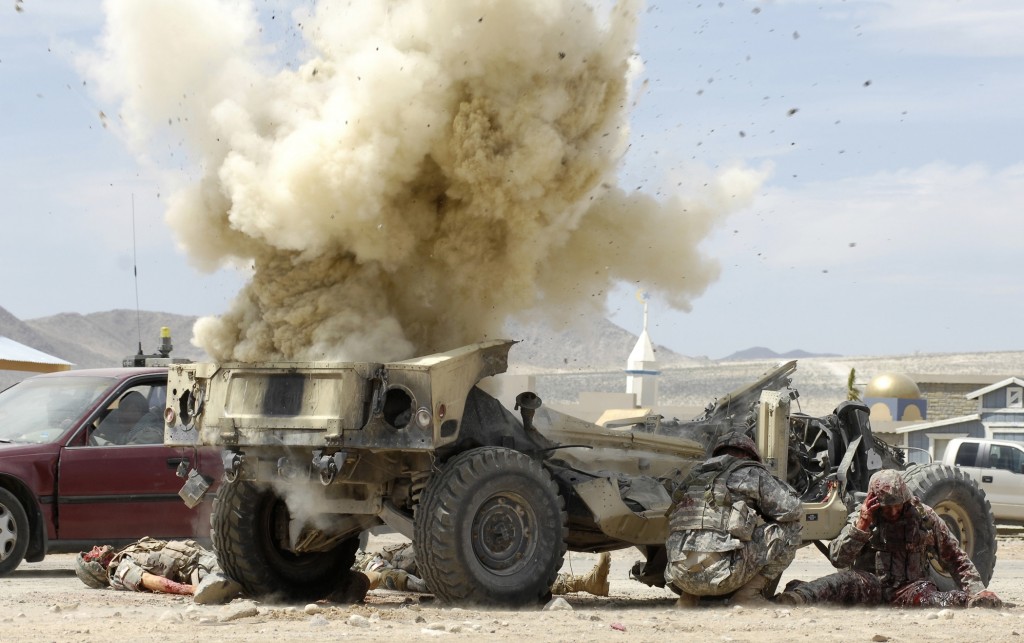Tiered Readiness Returns In Army 2015 Budget; Not All Brigades Ready to Fight
Posted on

Soldiers train at the notoriously realistic National Training Center at Fort Irwin, Calif.
PENTAGON: Last year, the sudden budget cuts known as sequestration forced the Army to cancel crucial training for 78 percent of its combat brigades. The budget request for 2015, released today, buys back a lot of that lost readiness — but not all. In fact, the Army has now officially resigned itself to what it once said it would never do: a system of readiness haves and have-nots, in which some units are never fully trained. That’s something the Army Vice-Chief of Staff, Gen. John Campbell, admitted was on the table when he talked to me in August, but now “tiered readiness” is the official Army plan.
The 2015 budget creates an Army Contingency Force — whose size is still to be determined — whose units will be funded to receive the latest equipment and the full training program, whose climax is a brigade-sized wargame at a Combat Training Center. The same priority of training and equipment will apply to the Army’s existing Global Response Force, a brigade of the 82nd Airborne (plus reinforcement) ready to airdrop into crisis zones on short notice, and to the remaining Army brigade in South Korea.
But the rest of the Army won’t get to go to the famously realistic and strenuous Combat Training Centers. In fact, instead of the entire brigade being able to train together in complex maneuvers at a CTC, the have-not Army will only be able to train smaller sub-units of each brigade at their home bases.
“This budget request seeks to sustain readiness achieved in FY ’14 with priority for forces in Korea, the Global Response Force, and the [new] Army Contingency Force,” Maj. Gen. Karen Dyson told reporters at the Pentagon today. “But for those units that are not assigned to one of these categories…training is expected to reach only to company level in some cases and in some select cases to battalion level.” And that’s in the regular active duty force. “The [Army National] Guard and the Reserves are funded to individual crew and squad level,” Dyson said.
Isn’t this “tiered readiness,” I asked Dyson. “Right,” she said. “Under tiered readiness… those in the contingency force will be prioritized for Combat Training Center rotations …. Others will be optimized for training at home station until we can bring the Army back in balance.”
So when is that? “Under the president’s budget, the Army will not begin to establish balance among readiness, endstrength, and modernization until after until after FY16,” Dyson said. What she didn’t say is that the president’s budget plan for 2016 and beyond also assumes that sequestration’s 10-year, $500 billion cut to defense spending will somehow be rolled back. That’s something the White House and Congress have consistently failed to come to an agreement to do.
The problem — as Army Chief of Staff Ray Odierno and others have repeatedly pointed out — is that sequestration cuts dollars faster than the military can cut people. (Troops sign contracts to serve for a given number of years, so if you want them to leave early, you have to buy them out, which means cutting personnel too quickly costs more money in the near-term than it saves). That’s especially problematic for the Army, the most labor-intensive service, with 46 percent of the Army budget going to military personnel.
The Army will go down to 490,000 regular active duty troops by the end of fiscal year 2015 and then to 450,00 or lower thereafter, depending on how fully the president’s plan gets funded. The Army can cut readiness spending almost immediately — that’s what happened to training exercises in 2013 — and it can cut equipment modernization relatively quickly as well — which is what’s happening in this budget. Until the personnel cuts catch up, readiness and modernization will have to pay a disproportionate share. That’s what Dyson et al mean when they talk about being “out of balance.”
“We want to keep the balance between modernization, readiness, and end strength,” Gen. Odierno said in February at the Council on Foreign Relations. “So even if we get too small, whatever’s left, we want to make sure it’s ready and modernized.”
But the proposed Army budget is the opposite of what Odierno said he wanted. For at least another couple of years, the Army is going to have more troops than it can afford to properly train. And that means, as every senior budget briefer from Defense Secretary Chuck Hagel on down has said, more risk.
“What keeps me up at night,” Odierno told the Council, “is if something [happen]s all of a sudden, I get a call saying I got to deploy 20,000 or 30,000 soldiers….we’ll go, but it’ll take us longer and it’ll cost us in lives.”
Subscribe to our newsletter
Promotions, new products and sales. Directly to your inbox.
